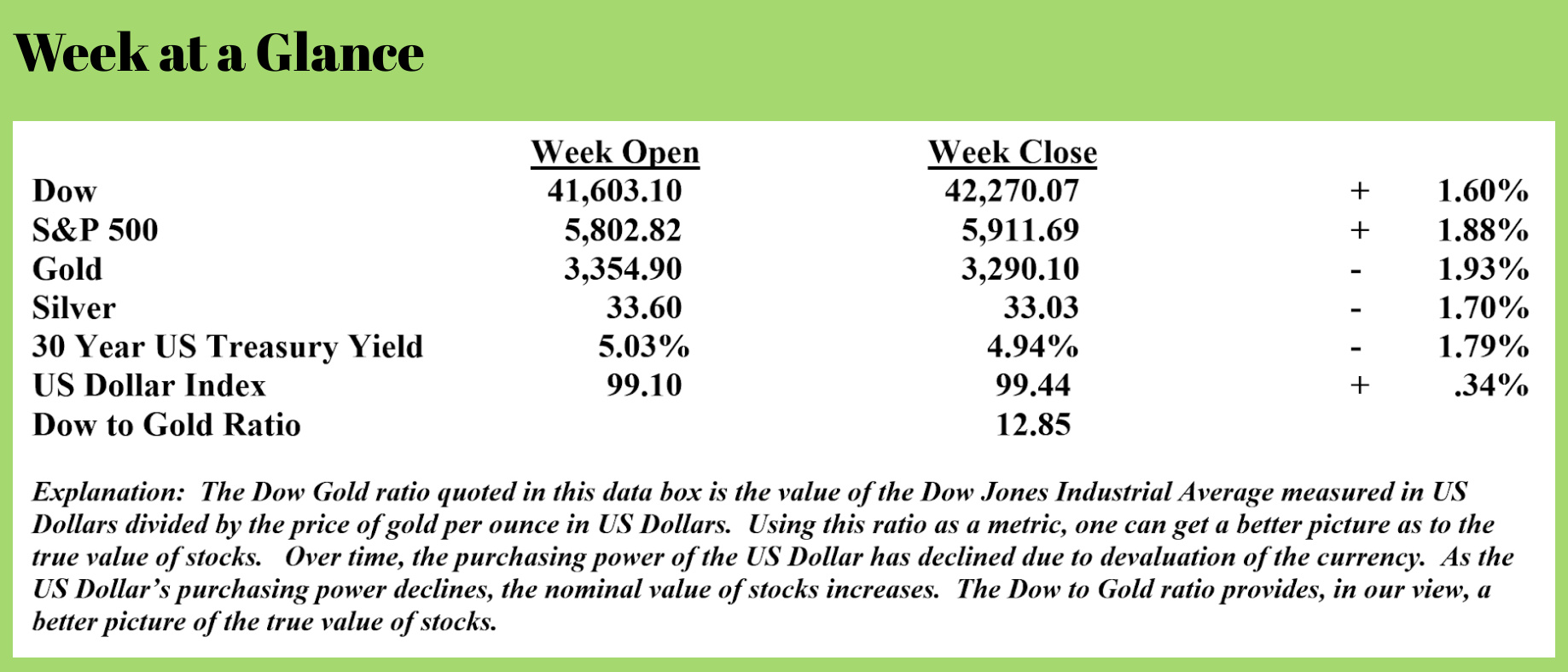
 Weekly Market Update by Retirement Lifestyle Advocates
Weekly Market Update by Retirement Lifestyle Advocates

Is a New Gold Standard on the Horizon?
For much of US history, the US Dollar has been gold or has been linked to gold. For example, until 1933, a one-ounce gold coin circulated as currency and was worth $20. It was in 1933 that President Franklin Roosevelt issued an executive order making it illegal for American citizens to own gold.
In July 1944, as part of the Bretton Woods agreement, the US Dollar became linked to gold. US Dollars could be redeemed for gold at a rate of $35 per ounce. That made the US Dollar the world's reserve currency, used in virtually all trade around the world. Countries were confident using US Dollars since they could be directly exchanged for gold.
That all changed in 1971, when President Richard Nixon closed the gold window.
It’s important to note that the exchange rate of dollars to gold increased from $20 per ounce to $35 per ounce, an arbitrary increase of 75%.
Could it be that something similar is on the horizon now?
History tells us that such an event is probable. Consider this quote from Dr. Ron Paul, former US Representative and Presidential candidate:
“More and more people are asking if a gold standard will end the financial crisis in which we find ourselves. The question is not so much if it will help or if we will resort to gold, but when.
All great inflations end with the acceptance of real money—gold—and the rejection of political money—paper.”
Past RLA Radio Guest, John Rubino, recently noted in his widely read substack newsletter that there are several reasons a new gold standard could be likely, with the first being massive gold accumulation by world central banks.
 He published this chart illustrating the relationship between the spot price of gold (the gold line on the chart) and net purchases of gold by central banks in tons (the bars on the chart). It’s easy to see the correlation between gold prices and central bank demand from this chart.
He published this chart illustrating the relationship between the spot price of gold (the gold line on the chart) and net purchases of gold by central banks in tons (the bars on the chart). It’s easy to see the correlation between gold prices and central bank demand from this chart.
At the very least, this accumulation of gold by central banks demonstrates a desire for tangible reserve assets in addition to fiat-currency-based assets; however, could it be that central bankers have studied history and know how debt crises end?
Mr. Rubino also points out that the elements of “Project 2025”, a document published and disseminated by the Heritage Foundation, contain a recommendation to return to a gold standard. Interestingly, Rubino also comments that 42% of the document’s recommendations have already been enacted. (Source: https://www.project2025.observer/)
Nick Giambruno, writing for “International Man” (Source: https://internationalman.com/articles/trumps-monetary-reset-is-a-gold-backed-dollar-on-the-horizon/), makes a lucid case for a return to a gold-backed money system.
He writes that the only way to address the debt crisis and trade imbalances is to devalue the US Dollar. Citing some of the history that I did at the beginning of this piece, Giambruno suggests that gold could simply be revalued at a higher price, like it was previously. That effectively devalues the US Dollar.
Giambruno suggests that one potential method that could be used to devalue the US Dollar would be to print dollars to buy gold in the open market, which would drive the price of gold higher and then devalue the dollar against it.
Giambruno concludes that, given the size of the debt and trade challenges, it’s reasonable to expect a much higher gold price as part of a possible solution. He suggests that a gold price of $10,000 per ounce, $20,000 per ounce, or even higher is possible.
If gold were revalued to $20,000 per ounce, the 261 million ounces that the US Government claims to own would immediately be worth more than $5 trillion. That would instantly strengthen the balance sheet of the US Government.
When reading Giambruno’s piece, I couldn’t help thinking about the February comments of Treasury Secretary Scott Bessent who said, “We’re going to monetize the asset side of the US balance sheet for the American people. We’re going to put the assets to work, and I think it’s going to be very exciting.” (Source: https://www.aol.com/finance/adjusting-bookkeeping-america-gold-reserves-165911866.html)
Could it be that the Treasury Secretary tipped his hand here?
At the time, as you may recall, I speculated that he did.
Monetary resets are nothing new. They’ve happened often throughout history.
As Dr. Paul noted, all great inflations end with the acceptance of real money – gold – and the rejection of political money – paper.
In my view, this time will be no different. We are only debating the ‘when’, not the ‘what’.
RLA Radio
This week’s RLA radio program features a "Best-of" replay of the interview that I did with Mr. Gerald Celente, the publisher of “Trends Journal”. In case you missed the original airing, you can listen now by clicking on the "Podcast" tab at the top of this page.
Quote of the Week
Paper money always returns to its intrinsic value - zero.
- Voltaire



Comments